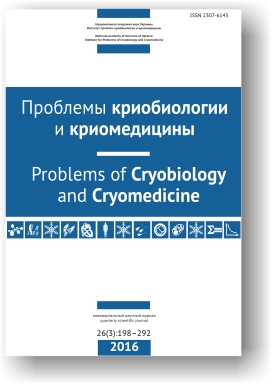Effect of Hydrogen Bonds on Crystallization Kinetics of Aqueous Solutions of Cryoprotective Agents
DOI:
https://doi.org/10.15407/cryo26.03.199Keywords:
cryoprotective solution, cluster crystallization, cluster particle, diagram of states, glass structure, hydrogen bondsAbstract
The temperature dependences of volume for aqueous solutions of DMSO and glycerol under various concentrations during their cooling down to –150°C and subsequent heating up to 25°C were studied in details in this paper. It was shown that within the range of 30–70% weight concentrations of cryoprotective substances these dependences differed greatly at cooling stages and during subsequent thawing. It has been also found that within the studied concentration range there was a sharp increase in volume for glycerol solutions when heated above the glass transition temperature, and vice versa, a sharp reduction in DMSO solution volume. It has been noted that the observed volume effects fit well within the concept of cluster crystallization of cryoprotective solutions, taking into account a weak HB-interaction between the components. On the basis of the findings the structure of the formed cluster particles was analyzed. It has been shown that the surface layers from the molecules of cryoprotective agent surrounding ice microcrystals can be of either crystalline or amorphous structure. The effect of these differences on protective properties of cryoprotectants was examined.
Â
Probl Cryobiol Cryomed 2016; 26(3): 199–212
References
Bevan O.J., Goates R.J., Lamb J.D. Solid-liquid phase equilibria in water + ethylene glycol. J Chem Thermodynamics 1972; 4 (1): 123–126. CrossRef
Bohon R.G., Conway W.T. DTA Studies of the glycerol-water system. Thermochim Acta 1972; 4 (3–5): 321–341. CrossRef
Boutron P., Kaufman A. Metastable states in the system water-ethanol. Existence of a second hydrate, curious properties. J Chem Phys 1978; 68 (11): 5032–5041. CrossRef
Boutron P., Kaufman A. Stability of the amorphous state in the system water-1,2-propanediol. Cryobiology 1979; 16 (6): 557–568. CrossRef
Cahn R.W., editor. Physical metallurgy. North-Holland Publishing Company, Amsterdam; 1970: 1333. PMID:PMC1930684
Cocks F.H., Brower W.E. Phase diagram relationships in cryobiology. Cryobiology 1974; 1 (4): 340–358. CrossRef
Friedel J, editor. Dislocations. Pergamon Press, Oxford; 1964.
Hochachka P.W., Somero G.W. Strategies of biochemical adaptation. Philadelphia; 1973.
Klimontovich Y. Statistical physics. Moscow: Nauka; 1982.
Landau L.D., Lifshitz E.M. Statistical physics. Moscow: Nauka; 1964.
Malsam J., Aksan A. Hydrogen bonding and kinetics/thermodynamics transitions of aqueous trehalose solutions at cryogenic temperature. J Phys Chem B 2009; 113 (19): 6792–6799. CrossRef PubMed
Osetsky A.I. Peculiarities of state diagrams of aqueous solutions of cryoprotective agents. Cryobiology 2009; 59 (2): 141–149. CrossRef PubMed
Osetsky A.I. Thermodynamic aspects of cluster crystallization in cryoprotective solution. CryoLetters 2011; 32 (3): 216–224.
Osetsky A.I. To theory of diagrams of state for cryoprotective solutions. Problems of Cryobiology and Cryomedicine 2014; 24 (2): 102–117.
Osetsky A.I., Kirilyuk A.L., Gurina T.M. On possible mechanism of damage in frozen-thawed biological objects due to pressure plastic relaxation in closed liquid phase inclusions. Problems of Cryobiology and Cryomedicine 2007; 17 (3): 272–282.
Osetsky A.I., Sevastianov S.S. Microvolumetric scanning tensodilatometer for biophysical studies. Science Rise 2015; 2 (7): 106–111.
Pagnotta S.E., McLain S.E., Soper A.K. et al. Water and trehalose: how much do they interact with each other. J Phys Chem B 2010; 114: 4904–4908. CrossRef PubMed
Rasmussen D.H., MacKenzie A.P. Phase diagram for the system water – dymethyl sulfoxide. Nature 1968; 220 (174): 1315–1317. CrossRef PubMed
Rasmussen D.H., Luyet B.J. Complementary study of some non-equilibrium phase transition in frozen solutions of glycerol, ethylene glycol, glucose and sucrose. Biodynamica 1969; 10 (220): 319–331.
Towey J.J., Soper A.K., Dougan L. Preference for isolated water molecules in a concentrated glycerol-water mixture. J Phys Chem B 2011; 115: 7799–7807. CrossRef PubMed
Towey J.J., Soper A.K., Dougan L. Molecular insight into the hydrogen bonding and microsegregation of a cryoprotectant molecule. J Phys Chem B 2012; 116: 13898–13904. CrossRef PubMed
Towey J.J., Soper A.K., Dougan L. What happens to the structure of water in cryoprotectant solutions? Faraday Discussions 2013; 167: 159–176. CrossRef PubMed
Zinchenko A.V., Mank V.V., Moiseyev V.A. et al. About phase transitions and physical states of water-propanediol system. DAN SSSR 1978; 240: P. 888–891.
Zinchenko A.V., Zinchenko V.D. On phase transitions in the water – ethylene glycol system at subzero temperatures under non-isothermal conditions. CryoLetters 2001; 22: 191–198.
Downloads
Published
How to Cite
Issue
Section
License
Copyright (c) 2020 Aleksandr I. Osetsky, Stanislav S. Sevastyanov

This work is licensed under a Creative Commons Attribution 4.0 International License.
Authors who publish with this journal agree to the following terms:
- Authors retain copyright and grant the journal right of first publication with the work simultaneously licensed under a Creative Commons Attribution License that allows others to share the work with an acknowledgement of the work's authorship and initial publication in this journal.
- Authors are able to enter into separate, additional contractual arrangements for the non-exclusive distribution of the journal's published version of the work (e.g., post it to an institutional repository or publish it in a book), with an acknowledgement of its initial publication in this journal.
- Authors are permitted and encouraged to post their work online (e.g., in institutional repositories or on their website) prior to and during the submission process, as it can lead to productive exchanges, as well as earlier and greater citation of published work (See The Effect of Open Access).




